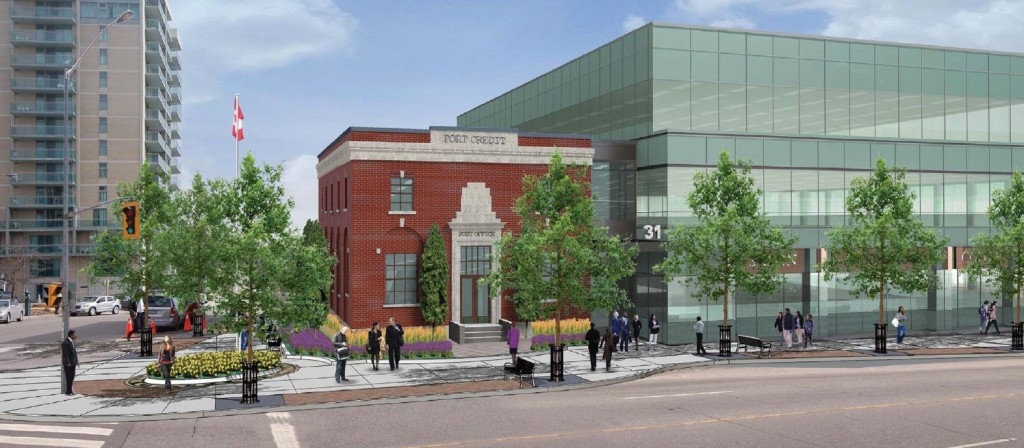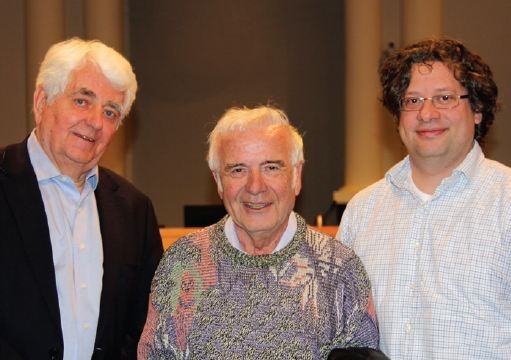A local developer takes the plunge and tries to do something positive with Port Credit’s postal station.

Words by Mike Douglas
The development industry is loaded with risk and frustration. A good example of this is in the challenges faced by Centre City Capital Limited (Centre City) in its recent application for the redevelopment of the former postal station, a heritage building on the corner of Stavebank and Lakeshore in Port Credit.
Centre City has been in business in Port Credit for over 40 years with Dr. Bill James at the helm. In the 1970s they established the Port Credit Harbour Marina and in the 1990s they bought a run-down old hotel (the Marco Polo) and redeveloped the property into The Waterside Inn, an award-winning boutique hotel including a four-diamond restaurant called Breakwater.
“The hotel consultants told us we were wrong,” explains Jonathan James, Vice President of Centre City. “The banks told us we were wrong and said we should put it into the City Centre, but we wanted to do it in Port Credit because we are from Port Credit. So we took the risk and we did it anyway.”
Similarly, with the post office site they saw an opportunity to reanimate an underutilized space at a major intersection in downtown Port Credit. “We are local developers, and as such we approach projects in Port Credit with a different sensitivity than other developers would,” says James. “Here was a chance to redevelop a site on the waterfront and breathe new life into it.”
City planners have been urging developers to come up with office space proposals, and the Mayor has long wanted to straighten out the dangerously offset intersection where Stavebank north and south don’t meet at Lakeshore Road.
Centre City saw redevelopment of the postal site as a way to accomplish all of these goals.
“We envision a restaurant with a large deck overlooking the adjacent park and harbour with retail space along the main street and office space above,” observes James. “We feel that Port Credit deserves and needs Class-A office space to attract high-quality employers into the area, which would help support local businesses. We also saw an opportunity to facilitate the straightening of the Lakeshore/Stavebank intersection, which is a high priority for the City.”
In March 2008, Centre City offered the highest bid but were dissuaded once “[they] did property and environmental inspections prior to closing,” says James. “The results indicated contamination costs and we withdrew.” He adds: “For the next two years, we heard that Canada Post made deals to sell it to several other developers.”
Outside developers saw that a decent return on investment and risk required a multiple-story condo tower; however the City wasn’t willing to rezone the site, so the post office sat, unused and unoccupied.
In the meantime, Canada Post reported a positive environmental assessment, assuring Centre City that while the site was contaminated, it wasn’t dangerous and it could be remediated when the underground parking was being built.
The postal station formally went on sale again and Centre City won the tender by proposing a commercial project that worked inside the current three-storey zoning restriction, while preserving the heritage component. James admits their rate of return on this investment is extremely low. “If this property was not in Port Credit, we wouldn’t touch it,” he concludes.
They approached architect Robert Grossman of Adamson Associates-Architects, a world-renowned architecture firm that had been based in Port Credit for 10 years. Adamson has designed projects around the globe including the World Trade Centre Towers 2, 3 and 4, and closer to home it has been involved in the design of Terminal 1 at the airport, the MaRS Discovery District in Toronto, and the New Oakville Hospital as well as the redevelopment of The Waterside Inn. Ironically, in 2008 they had to move to Toronto because they couldn’t find enough office space to grow in Port Credit.
Grossman got excited walking the postal site with Bill James, President of Centre City. But there were challenges. The site is irregularly shaped, which presents design issues and increases costs related to underground construction. Due to the proximity of the site to water, the proposed underground parking necessary to attract tenants to the building would be partially below the water table, so it must be pumped out as they dig. As well they must integrate systems to continuously dissipate the water once it’s built. The site itself is quite sloped which presents design challenges when trying to achieve easy pedestrian access and consistently level floor plates suitable for tenants. All these issues needed to be resolved while working with and around the original 1931 Dominion Public Building.
“Our vision for the design of the office addition was inspired by the simple, rectangular classic Edwardian architecture of the original 1931 brick post office building,” Grossman explains. “The additions [in 1953 and 1966] to the building have a somewhat industrial warehouse appearance. Our contemporary glass addition will respect and reflect the same simple geometric composition of the original. The contrast in materials will enhance the appearance of the original building while highlighting architectural beauty that is not currently visible.”
In April 2012, Centre City submitted their site plan application to the City of Mississauga for a two-storey retail/office building, including the heritage restoration of the original 1931 building. They worked with the City’s planners including their urban design and heritage teams, and through that process the design continued to be fine-tuned.
At the request of Ward 1 Councillor Jim Tovey and City staff, another floor of office space was added to the development to allow for more employment opportunities. “We knew it was a risk, to add a third storey to the development,” James says. “Does it make the building look better? Absolutely, but it increases our construction risk, financing risk and leasing risk. We ultimately agreed to take those on.”
On November 20, 2012, in Council chambers, the Heritage Advisory Committee (HAC) met to approve the heritage designation and the partial demolition of the Port Credit Post Office. Grossman introduced their design and cited the glass building as a successful complement to great heritage sites around the world. He argued for simplicity.
Notable members of HAC liked the design and thought it promised a great addition to the community. There was some opposition from members of a local ratepayers’ group promoting their own design for the site.
For Susan Burt, Director of Culture for the City of Mississauga, their heritage evaluation had not changed. “The City’s Heritage experts agree that the original 1931 portion of the three-stage postal depot has heritage import,” she says. “Specifically, that means that at least two walls of the original building have to be protected and preserved.” Centre City has always agreed to this and incorporated it into their design. HAC endorsed the redevelopment plan in principal, pending a further review of changes to the design based on their comments.
The general consensus in the community and at City Hall is that this is a positive redevelopment. Ellen Timms, General Manager of the Port Credit Business Improvement Association (which represents over 600 local businesses), declared the BIA’s enthusiastic support for the three-storey office building.“We need the jobs and feel that it would keep this part of our city animated, and we thank the James family for their investment in this community,” she says.
Councillor (and HAC member) Tovey agreed, saying: “This really fits; it has a clearly defined heritage portion. You are operating on small margins and are preserving it as best you can, and you have done a good job of working with staff all along.”
In January, the objecting ratepayers association called an emergency meeting of its membership to discuss tactics for fighting the redevelopment proposal at the upcoming HAC meeting, but few members attended.
On January 22, 2013 at the second HAC meeting, Grossman, representing Centre City, shared the changes they made and Committee members largely accepted them. HAC passed the motion to approve the project.
At the General Committee on January 30, Councillor Carlson, the Chairman of HAC, described the project as a “model example of an adaptive reuse of property.” Mayor McCallion added that while heritage is one component to consider in a project like this, the economic benefits to the City and traffic safety improvements also need to be considered. The annual increase in property taxes to the City on the redeveloped property will likely go up tenfold.
The Councillors approved the HAC’s recommendation. At the subsequent Committee of Adjustments hearing, the project was again introduced by Grossman. The Committee of Adjustment (COA) is a panel made up of citizen members who hold public hearings to consider applications for minor variances, such as small changes or exceptions to development restrictions contained in zoning bylaws.
At this meeting, in addition to a small group of persistent critics, several new speakers appeared to advocate for the project, including representatives from another local ratepayer group, the BIA and local businesses. The COA panel voted unanimously in support of the new office and retail plan.
Their promising project has survived. The Centre City team returns to work on construction challenges, looking for tenants and trying to do something positive for Port Credit.
^ Architect Robert Grossman (L) with Bill James (C), President of Centre City and Jonathan James (R), Vice President.
